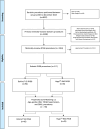Comparison between DaVinci® and Hugo™-RAS Roux-en-Y Gastric Bypass in bariatric surgery
- PMID: 39105863
- PMCID: PMC11303586
- DOI: 10.1007/s11701-024-02063-w
Comparison between DaVinci® and Hugo™-RAS Roux-en-Y Gastric Bypass in bariatric surgery
Abstract
The application of a robotic platform in the bariatric surgical field is intended to enhance the already established advantages of minimally invasive surgery in terms of both technical and clinical outcomes. These advantages are especially relevant for technically challenging multiquadrant operations such as Roux-en-Y Gastric Bypass (RYGB). Consequently, robotic-assisted surgery has emerged as a possible application for bariatric surgeries. The study attempts to assess feasibility and safety of the Hugo™-Robotic-Assisted Surgery System (Hugo™-RAS) platform compared to the DaVinci® Surgical System (DaVinci®-SS) with a focus on complication rates and operative times. We retrospectively reviewed bariatric procedures performed from January 2013 until December 2023. We included all robotic RYGBs performed using Hugo™-RAS and DaVinci®-SS platforms. The study utilized Propensity Score Matching (PSM) analysis to address bias in selection, matching patients based on age, gender, body mass index, comorbidities and past abdominal operations. One hundred thirty-five patients were identified: 90 DaVinci®-SS and 45 Hugo™-RAS procedures. After PSM, each group consisted of 45 patients. There was no discernible disparity observed in relation to early (≤ 30 days) postoperative complications rate (p = 1), mean operative time (for docking time, console time and total operative time: p = 0.176, p = 0.678, p = 0.229, respectively) and postoperative hospital stay (p = 0.052) between DaVinci®-RSS and Hugo™-RAS procedures. Our results suggest that application of both Hugo™-RAS and DaVinci®-SS robotic platforms to RYGB is related to comparable safety profiles. Although DaVinci®-SS remains the most widely adopted platform in clinical practice, this study underscores the potential role of the Hugo™-RAS to provide effective solutions in robotic bariatric procedures.
Keywords: Complications; DaVinci®; Hugo™-RAS; Outcomes; Roux-en-Y Gastric Bypass; Severe obesity.
© 2024. The Author(s).
Conflict of interest statement
Marco Raffaelli has entered into consultancy agreements with Medtronic, AB Medica, and Intuitive Surgical. Priscilla Francesca Procopio, Francesco Pennestrì, Pierpaolo Gallucci, Luigi Ciccoritti, and Francesco Greco are engaged in a consultancy agreement with Medtronic. Giuseppe Marincola and Giulia Salvi do not have any conflicts of interest to disclose.
Figures
References
-
- Veilleux E, Ponce J, Lutfi R (2020) A review of the role of robotics in bariatric surgery: finding our future? J Laparoendosc Adv Surg Tech 30:36–39. 10.1089/lap.2019.0419 - PubMed
-
- Ozsoy Z, Demir E (2018) Which bariatric procedure is the most popular in the world? A bibliometric comparison. Obes Surg 28:2339–2352. 10.1007/s11695-018-3163-6 - PubMed
-
- 7 th IFSO Global Registry Report (2022)
-
- Dalager T, Jensen PT, Eriksen JR et al (2020) Surgeons’ posture and muscle strain during laparoscopic and robotic surgery. Br J Surg 107:756–766. 10.1002/bjs.11394 - PubMed
-
- Bindal V, Sethi D, Pandey D (2021) Robotic primary bariatric surgery. Dig Med Res 4:56–56. 10.21037/dmr-21-33
Publication types
MeSH terms
LinkOut - more resources
Full Text Sources
Medical
Research Materials
Miscellaneous



